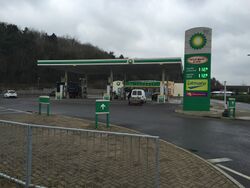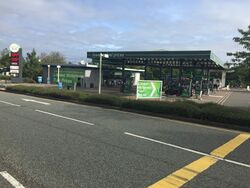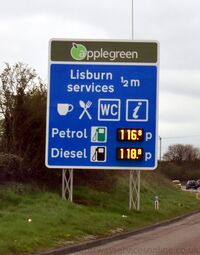Petrol Stations

This page is about the topic of fuel. For the current price of fuel, you need to consult the fuel brand in question.
A petrol station, filling station, forecourt, PFS (petrol filling station), FFS (fuel filling station) are all phrases which effectively describe the same thing. It's also colloquially known as a 'garage' or 'service station', though those phrases are also used to describe mechanics and service areas.
While petrol stations can be found all over the world, this page looks at their contribution to service areas. All signposted service areas (on motorways and on A-roads) are required to sell fuel, but rest areas are not. The petrol station is the only service area facility which you can be sure will be open at night, and it's normally the one thing people expect to find in a service area.
Although most petrol stations are supplied by one of the major oil companies, and covered in their branding, sometimes they are ran by somebody else. At motorway services, it always used to be the operator. As Moto and Roadchef wanted to focus on catering, they have since sold most of their forecourts to the likes of EG Group. This has created the unusual situation where the two neighbouring facilities are effectively competing with each other to sell food.
Within the industry, the phrase 'petrol station' is out of favour, because they sell a lot of diesel and alternative fuels too. Most people still describe the facilities as 'petrol stations', with official terms like 'filling station' or 'forecourt' (which actually describes the manoeuvring area) sounding a bit clinical.
The biggest petrol station in the UK is believed to be the Shell forecourt at Cobham services, which opened in 2012 and has 36 pumps across six islands.
Fuel Pricing
Petrol stations on motorways and major roads frequently receive complaints that they charge prices well above the prices charged locally, especially when compared with supermarkets. Newspaper articles frequently point out that as much as 20p per litre can be saved by driving a few miles. Operators have been reluctant to comment on why their prices are so high, occasionally muttering about high operation costs or pressure from the forecourt brand.
There is a little bit of truth in this. The cheap fuel that is sold in supermarkets makes very little profit, if any. This is fine for a business which is able to subsidise it, but traditionally motorway services were run on tight profit margins with high running costs. Regulations also made it difficult for them to cross-subsidise because motorway service areas are supposed to be competing with each other and not with neighbouring towns.
In practice, a lot of customers of motorway petrol stations are charging the price to their employer, so they are not worried about the bill. This leads to motorists accusing the forecourt of taking advantage of a captive market. Some business fuel cards even charge a flat rate across the country, irrespective of the advertised price.
Complaints about motorway fuel prices were common as early as the 1970s, but a government study found that the prices were not unduly high and that some of the associated offers made for good value.
Petrol stations are not required to advertise their fuel price, but it is common practice that they do, if only to avoid disappointment at the pumps. Highway authorities have explicitly ruled out taking action against service areas with seemingly excessive fuel prices.
Away from the motorway, rural petrol stations usually look at other fuel prices within a 30 mile radius before setting their own, paying particular attention to what's charged further along the same road.
Motorway Price Crash

Over the years, several individual service areas have trialled selling fuel at a cheaper price, but they have quickly reverted to their standard pricing structure. Two high profile examples were Washington and Southwaite, as well as the 1996 Esso 'price watch' campaign.
After Welcome Break were taken over by Applegreen, who are known for their competitive fuel pricing, it briefly looked like there could be a full motorway price war. Welcome Break moved their branding close to Applegreen's, and at Hopwood Park they committed to "lowering fuel prices" and the "lowest motorway fuel prices", while Moto's adjacent Frankley services announced that it would compete with local petrol stations (though specifically not supermarkets); this was the first time in a long time that two adjacent motorway forecourts had both sold fuel at reasonable prices.
In the event, Welcome Break abandoned that business model, but Moto remain committed to rolling it out. They commissioned a specially-created road sign to promote their cheaper fuel prices. Progress has been glacially slow as each new sign needs specific approval. Even Moto have hit out this, saying that they were ready to roll the discount out nationwide. They looked at advertising their prices from signs on their land.
Meanwhile, in July 2021, Welcome Break launched a "10 pence per litre off when you spend £10 on food" promotion, similar to the promotions offered by supermarkets. This is a rare example of a service area actively pushing its fuel sales, and is perhaps more familiar territory for them, as the cost is tied to their existing food sales. At their new Rotherham site, which was designed by Applegreen, the fuel price sign is positioned to be visible to passing traffic; many visitors commented on the high prices.
Motorway Forecourt History

When the first motorway services were being designed, the emphasis was on the motoring side of things. Operators were expected to sell fuel, repair broken vehicles and operate a recovery service - the food and toilets were almost a mere a bit on the side. Those 'services' that were available for your vehicle are the reason that today we tend to call these places "service areas", "service stations" or just "services".
In addition, the government were very concerned about a fuel monopoly, so they required at least four brands of fuel to be made available - and those brands had to be agreed in writing and each sourced separately. That suggestion dated back to an investigation by the Monopolies and Restrictive Practices Commission into so-called 'solus' petrol stations which took place shortly before the first motorways opened. They published a report in 1965, when there were a handful of motorway services open, which remarked that the Ministry of Transport needed to ensure that budget fuel brands aren't pushed out of motorway sites.
The problem with this idea was that the government were now looking for a developer which was an expert in catering, refuelling and vehicle maintenance all in one go, which left a very narrow pool of entrants. Their policy on variety meant that none of the oil brands were interested, further reducing the pool.
The motoring industry changed fast at this time, and the requirement to sell four brands of fuel was informally reduced to two brands in 1973, and then this and other regulations were removed all together in 1979. What followed was a long period where the petrol station appeared to be completely detached from the rest of the service area, while the operators invested mostly in food and retail.
In the late 1980s, as service areas were starting to break free from government planning, oil companies like Esso started taking a key role in designing new service areas. The main operators would then only be involved in the main building.
The sales shops also started to become larger, to the point where it is now often a mini-service area in itself, filled with items for sale. They would sometimes be called "mini-markets", referring to the variety of items on sale, and the service they provide in small villages.
By selling food, hot drinks, fuel and having toilets, the larger of these petrol station sales shops are now ticking all the boxes expected of a service area, leaving any other facilities (including the main building) free to open and close as they wish. At smaller service areas, the forecourt shop and main amenity building tend to be combined into one.
The Applegreen/Welcome Break business model of being a fuel brand as well as a food one is like a return to old times, where the whole service area is run under one brand name.
Away from motorways there is no formal planning process, and both oil brands and service area operators can buy land where they think it would be profitable. The two fastest-growing major operators appear to be Euro Garages and Applegreen, both pursuing a policy of building a forecourt and surrounding it with food names. These often appear as a gateway to new residential and commercial developments, using their variety of brand names to pull people in.
There are no specific regulations attached to petrol stations at service areas. Operators are "encouraged" to provide free air and water, and to cater for a variety of fuels and vehicle types, but no more detail is provided.
The Future Of The Forecourt
With the British government looking to effectively phase out the use of petrol and diesel vehicles, the demand for a traditional petrol station is only going to decline. Many have already been relying on retail or food sales to boost business.
Many forecourt operators have been investing in electric vehicle charging networks, and GRIDSERVE have been developing forecourts where all the 'pumps' are replaced by electric chargers.
However, the current regulations (updated in 2022) still force all signposted roadside service areas to sell petrol and diesel fuel. Electric-only forecourts are not recognised at all. It's not clear when, or if, this will be changed.
In practice, since the 2010s, the pattern has been that the UK's traditional fuel brands which have so far dominated the industry, are now losing interest in the market. This is because other retailers like Rontec and EG Group have been able to make more profit by combining fuel sales with food and coffee. The fuel brands have tried to do the same, but they don't have the experience or partnerships that their new rivals have. As a result, fuel brands are increasingly selling their UK sites to retailers, so they can then focus on other countries.
Road Signs

See also: Motorway Signs
Since 1982, motorway signs have been expected to specify the price of fuel. This fell out of favour because it was too difficult to keep up to date.
Since 2012, the forecourt brand logo is expected to be shown on signs, and a fuel price comparison sign has been experimented with on the M5. The sign, initially popular with motorists, didn't appear to increase competition.
The symbols work as follows. While they are supposed to be informative, historically the signs they are attached to haven't been kept up-to-date, and nowadays they tend not to be used.
- white pump symbol on a blue or green sign: generic forecourt sign (added 2002)
- black pump symbol on a white sign: generic forecourt sign (added 2002)
- black pump symbol on a blue or green sign: diesel fuel
- green pump symbol on a blue or white sign: unleaded fuel
- four circles: Four Star fuel
- pump symbol with a round head: old-style generic symbol (removed 1994)
- separate 'LPG' symbol: LPG is available (added 2002)
- separate electric car symbol: a charging point is available
Any issues with fuel provision should be reported to the highway authority so that, where possible, they can warn drivers with electronic or fixed warning signs. This happens a lot when there is a nationwide fuel shortage, which can cause chaos in built-up areas.
As discussed above, Moto have created a bespoke road sign which follows the 2012 style, but instead of showing the brand of fuel, it has an electronic display showing the price for diesel and petrol. Despite a successful trial, it must still be approved on a case-by-case basis.
In both Northern Ireland and the Republic of Ireland, online motorway service areas must have their fuel price visible from the road and they have bespoke road signs to do this.